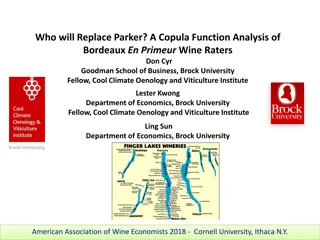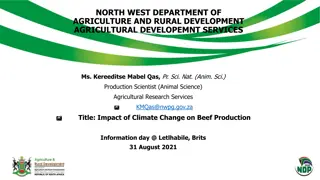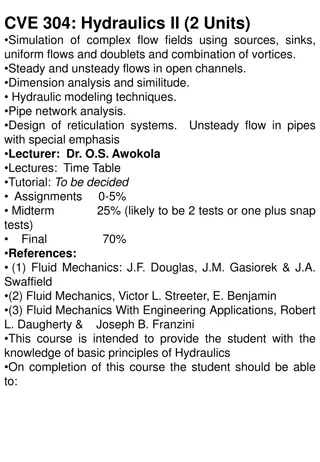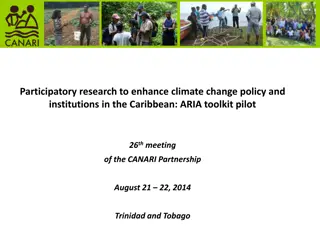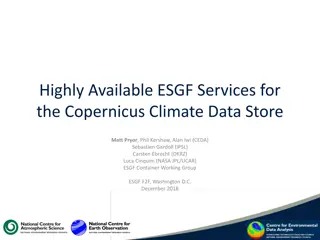Vine Hydraulics and Wine Production in Falanghina: A Study on Sustainability in the Context of Climate Change
This study focuses on analyzing the relationships between vine hydraulics and wine production in Falanghina grapes to evaluate sustainability in the face of climate change challenges. By monitoring resource efficiency and allocation in vine development up to must production, the researchers aim to understand the influence of water availability on grapevines, grapes, and wine quality. Using a multidisciplinary approach and in-vivo plant monitoring, the study assesses the eco-physiological history of vines in different vineyards and how cultivation practices and climatic variables impact grape yield and quality.
Download Presentation

Please find below an Image/Link to download the presentation.
The content on the website is provided AS IS for your information and personal use only. It may not be sold, licensed, or shared on other websites without obtaining consent from the author. Download presentation by click this link. If you encounter any issues during the download, it is possible that the publisher has removed the file from their server.
E N D
Presentation Transcript
General Assembly 2020 EGU session SSS9.3: Biogeosciences and wine: The management and the environmental processes that regulate the terroir effect in space and time Relationships between vine hydraulics and wine production in Falanghina: morpho-functional and isotopic traceability to evaluate sustainability in a climate change context Damiano N.1*, Cirillo C.1, Battipaglia G.2, Amitrano C.1, Pannico A.1, Caputo R.1, Arena C.3, Erbaggio A.4, Cherubini P.5, Saurer M.5, Bonfante A.6, De Micco V.1 (1) Department of Agricultural Sciences, University of Naples Federico II, Portici (Naples), Italy; *nicola.damiano@unina.it (2) Department of Environmental, Biological and Pharmaceutical Sciences and Technologies, University of Campania "L. Vanvitelli", Caserta, Italy (3) Department of Biology, University of Naples Federico II, Naples, Italy (4) Freelance (5) Swiss Federal Research Institute WSL, Birmensdorf (Zurich), Switzerland (6) Dept. Scienze Bio Agroalimentari DiSBA, Institute for Mediterranean Agricultural and Forest Systems, National Research Council of Italy, Ercolano (Naples), Italy
Context Climate change in the Mediterranean Region is responsible for increasing temperature and frequency of extreme events, such as prolonged periods of drought Climate change is intensifying the need to improve the resource use efficiency of crops (e.g. water use efficiency) and to increase yield, quality and stability of productions, especially in high profitability and vulnerable crops as grapevine A deep knowledge of the plasticity of vine morpho-functional traits in response to environmental constraints can help achieving the correct management of cultivation factors towards sustainability
Objective To monitor the resource use efficiency and resource allocation during vine development up to must production: With a multi-disciplinary approach analysing the complex relationships between parameters in the continuum environment-plant-must; With a specific emphasis on the influence of water availability on the vine, grapes, must and finally wine, in order to relate climate, plant water status and must characteristics. Study sites: Four vineyards located in La Guardiense farm at Guardia Sanframondi (BN, Italy) Vineyards were homogeneus for cultivar and rootstock but characterized by different pedo-climatic conditions
Approach In-vivo plant monitoring Retrospective analyses Multidisciplinary approach Reconstruction of the vine eco-physiological history, applying dendro-sciences techniques Evaluation efficiency in response to cultivation practices and climatic variables in 4 phenological phases: of the plant growth Study sites Applying: Analysing: Grottole-GR Santa Lucia-SL Dendro-ecology Dendro-anatomy Dendro-isotopes Morphological traits Yield and quality of grapes Eco-physiology Leaf structural traits and stable isotopes Calvese-CA Acquafredde-AC Guardia Sanframondi (BN)
Materials and methods Morphological characterisation and Eco-physiology Fluorescence a Chlorophyll Gas exchanges Biomass accumulation of bunches Shoot length Number of leaves Leaf area Fruit set percentage Weight and number Net photosynthesis Transpiration rate Stomatal resistance Fv/Fm NPQ Retrospective analyses Anatomical wood analysis on cores Stable isotopes analysis Ring width Lumen area Lumen area distribution Wood density Vessel frequency Isotopic ratio C / C Isotopic ratio O / O Leaf, wood, must Lumen area Ring width
Results 1.00 0.80 0.60 0.40 0.20 0.00
Conclusions Preliminary results of the reported study case confirmed the effectiveness of combining in-vivo measurements and retrospective analyses to assess vine plasticity in response to changing pedo-climatic conditions. Differences in plant growth and production yield were observed among the selected vineyards and highlighted by both in-vivo and retrospective analyses. The approach proved to be promising for achieving a comprehensive understanding on the impact of environmental constraints not only on plant behavior, but also on the characteristics of the oenological products. Thank you for the attention











